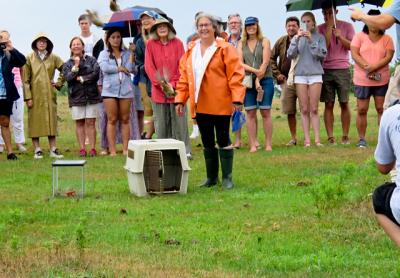Nature Notes: Return of the Bobwhite

On Saturday the rains came, but it didn’t spoil the first ever release of bobwhites in the hamlet of Montauk by the Third House Nature Center group. Juvenile bobwhite after bobwhite fluttered off into the green tapestry of Montauk County Park atop the hills east of Lake Montauk. Such release of this quail species, native to most of the United States, but not common anywhere, could be the beginning of the comeback of it not only in Montauk, but in the rest of East Hampton Town as well. Two more release days are planned by fall in this five-year program.
The first order of priority in beginning such a repopulation effort, one of several across Long Island, is having a stock of bobwhites to release. For that you need a dedicated individual — not a paid government bureaucrat, mind you, but some ordinary private citizen with a little extra time on his or her hands and a place to hatch and raise chicks safely and lovingly. While the New York State Department of Environmental Conservation raised pheasants in Ridge, in Brookhaven Town, in the 1950s, such operations have ceased and now it is up to dedicated volunteers to take on the challenges.
Such it was that in Montauk along came Jessica James, a woman who raises chickens, is a community activist, an E.M.T., vice president of Concerned Citizens of Montauk, a member of the hamlet’s citizens advisory committee, and a volunteer where and when good causes arise, the re-establishment of the bobwhite population being a very good cause.
Growing up in New Jersey, she summered with her parents in a Leisurama house in Montauk, just east of Culloden, west of Lake Montauk, and south of Block Island Sound. When she was 13 she made plans to one day return to Montauk and establish her home there; she even drew up plans for the house she wanted to build and live in. Forty years later after living in England, California, and scurrying here and there, her dream came true. She now lives in the house of her childhood dreams south of the state golf course surrounded by lush vegetation and varicolored chickens.
It was Montauk locals who first apprised her of the old days when bobwhites and ruffed grouse were not uncommon. They raised the possibility that the Lyme disease outbreak of the 1980s and the black-legged tick that was the cause of it may have had something to do with the bobwhite shortage. It is well known that quail just out of the egg are precocial and will begin feeding on tiny creepy-crawlers including ticks. Why not bring back the bobwhite and see if the tick population that has plagued Montauk for 40 years decreases accordingly?
She knew about the Third House Nature group newly established at the Montauk County Park east of Lake Montauk, and its tireless efforts to educate and preserve Montauk’s flora and fauna, so she went to that group with the idea. Of course, the members applauded it and she was on her way. First, she had to find sources of bobwhite eggs, and she found several, one in Pennsylvania that came with the expert commentary of the individual who had been raising quail for a long time. Since she had been raising chickens for a long time she had very little trouble incubating quail eggs, hatching them out, and dividing the hatchlings into family groups where individual quail chicks would get to know one another and form coveys.
She soon discovered one bothersome fact that can put a damper on quail husbandry: Some chicks are more aggressive than others and will peck at other chicks, killing them unless they are removed. It is this same perpetual pecking nature that keeps the chicks alive and growing and might serve to reduce the ambient tick population. When you spend hours and hours, weeks and weeks, months and months raising a unique species you get to know its ways better than anyone.
While a student at University of California Santa Barbara, I raised paradise fish, a colorful species from Southeast Asia and a relative of the popular Siamese fighting fish. I once had thousands of them and after two intense years of fish culturing almost became more of a paradise fish than a human.
The Suffolk County park rangers were supportive of Jessica’s efforts. Ticks, of course, are a major problem in Suffolk County parks, many of which have habitats of low shrubs and grasses that ticks thrive in. During the release on Saturday, parks employees and other county workers were present, as were several of Montauk’s old-timers.
It rained on and off for a few days after that, and so it remains to be seen how the liberated chicks will fare. It is not expected that all will escape the grasps of hawk talons, foxes, weasels, feral cats, and the occasional wild dog, but some should. And the promise of two more releases this year, as well as many more over the five years of the raise-and-release program, bodes well for Montauk.
But it wouldn’t be at all possible if it weren’t for a woman who as a child summered in Montauk, came back to the place of her choice after many years away, and settled in to help keep Montauk as she remembered it, an Eden for plants, wildlife, and people.
Larry Penny can be reached via email at [email protected].
